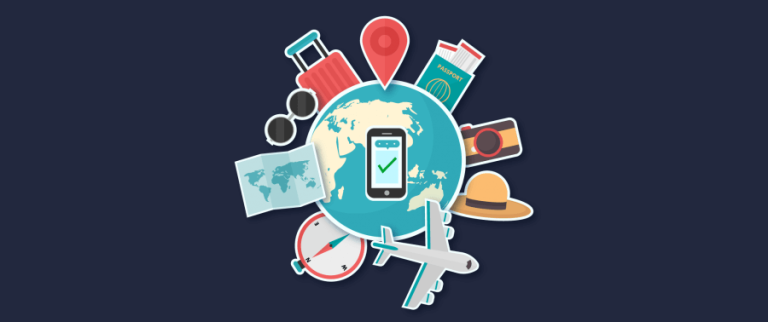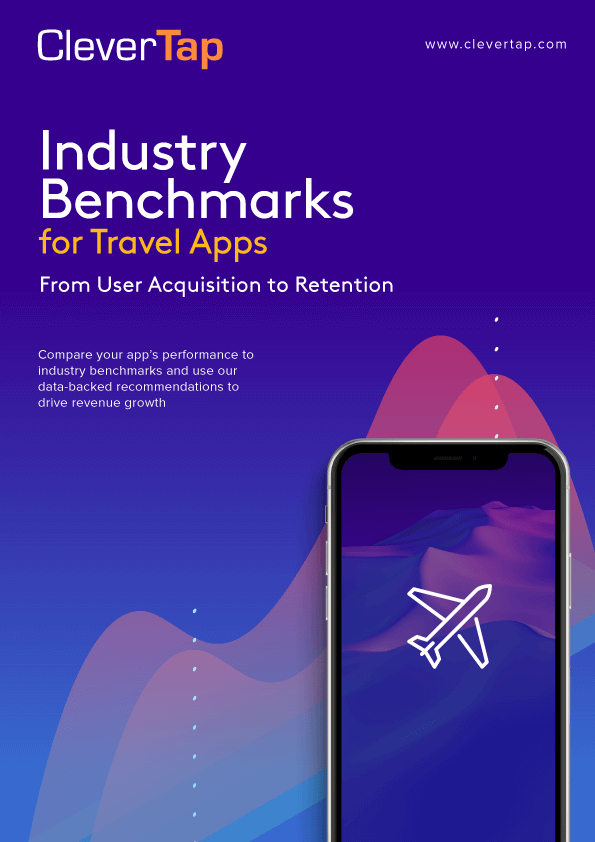As of 2017, there are 2.4 billion smartphone users — and that number is likely to rise to over 6 billion by 2020. This provides an immense opportunity for travel apps like yours to capture a growing market and rise above the competition.
More than 50% of users that browse and book trips online use mobile devices. However, more than 80% of newly acquired users stop using travel apps within 90 days.
Without a well-executed engagement strategy, you might fail to retain users and effectively waste all the effort and resources you put into acquiring them.
6 Travel App Marketing Campaigns to Drive Engagement
User onboarding is the first step in effective user engagement. Only when you’ve successfully delivered that first aha! moment can you launch effective engagement campaigns that drive adoption and reduce churn.
In order to create effective engagement strategies, you need to consider:
- Your target user base’s behavioral trends
- The app’s core function, utility, and benefits
- Competitor strategies
- Budget
Once you’ve considered these specifics, you can develop effective engagement campaigns that result in higher marketing ROI.
- First Purchase Engagement Campaigns
I’ve addressed the importance of travel app user onboarding in a previous post. Once your users have been successfully onboarded, you need to prompt them to convert.
One way to guide a user down the conversion funnel is to persuade them to conduct an in-app search for flights, hotels, car rentals, etc. Be sure to show multiple search results that fit the user’s budget or search parameters.
Such campaigns can be built around personalized in-app and push notifications. This also opens up cross-selling opportunities.
For instance, if a user based out of New York is looking to book hotel accommodations for a week-long trip to Madrid, you can prompt them with an in-app or personalized push notification highlighting limited-time promotions on flights from LaGuardia to Madrid.
This way you aren’t just meeting the user’s immediate search requirement, but also going the extra mile to offer additional travel-related options guaranteed to enrich the user experience. - Abandoned Cart Engagement Campaigns
Compared to other industries, cart abandonment rates are significantly higher for travel apps — over 80%.
Here are some of the major reasons why:- Users are simply browsing and have no real intention to purchase
- Users are just beginning to plan a holiday and need more time to make a decision
- Available prices don’t fit the user’s budget
- Inconvenient payment options
- Booking process is too long and/or complicated
Technical difficulties or app crashes
Effective user engagement campaigns can help you recapture these lost sales and keep users coming back to your app.
With personalized push notifications, you can send compelling calls to action so users complete their booking within the prescribed window of engagement (generally within 30 minutes of an abandoned cart occurrence). The idea is to provide enough incentive through discounts, product-bundling deals, and location-specific highlights to encourage a purchase.
You can also run an email drip campaign on days 1, 3, 5, 7, and 10 from the day of cart abandonment to ensure top-of-mind recall and booking reminders. Be sure not to spam users, and provide only relevant information and incentive to increase chances of conversion.
Additionally, by using social media remarketing, you increase the chances of bringing back users to your app. According to AdRoll, 2% of shoppers convert on their first visit to an online store. Retargeting attempts to bring back the other 98%.
Learn how CleverTap can help you create highly focused micro-audiences with our industry-first live-user segmentation engine, and read our tips for engaging users through Facebook remarketing.

- Post-Purchase Engagement Campaigns
Congrats! You’ve managed to secure the first purchase from a new user. But that’s only half the battle — the end-game is always to keep users coming back over the long term.
To convert a first-time user into a repeat customer, you need a different kind of engagement campaign.
Suggest personalized travel destinations and itineraries, and send destination-specific information like weather forecasts, packing lists, popular attractions, top restaurants, etc. to enrich their travel experience.
Use in-app notifications, personalized push notifications, and emails to send this helpful information and build user loyalty and retention.
For inspiration, look at how Expedia provides timely travel updates, reminders, and notifications.

This notification can further be improved by making it more specific, reminding users that check-in begins at 3 pm. It should be sent at least 2 hours before the actual check-in time.

- Location-Specific Engagement Campaigns
One way to up your user engagement game is by creating campaigns rich media campaigns based on the user’s destination, like personalized push notifications and emails that include relevant information on major tourist attractions, popular restaurants, local sights, cultural festivals, and shopping venues.
For our New Yorker interested in traveling to Madrid, for example, you could highlight details about top tourist attractions such as the Prado National Museum, Retiro Park, and the Semana Santa festivals.
The idea is to provide the user with enough details to help them picture themselves at these places, ignite their wanderlust, and persuade them to book the trip. Once again, Expedia gives users the opportunity to identify and book location-specific experiences of interest within the app.

And Expedia’s “Local Expert” option highlights location-specific attractions and activities.

- Reward-Based Engagement Campaigns
Early-bird discounts, purchase incentives, loyalty points, and exclusive access to new features or promotions can quickly build customer loyalty.
Using our industry-first live-user segmentation engine, you can identify users who have made at least 5 booking purchases across your web and mobile platforms, and immediately have a target-ready user segment to pitch your loyalty program.
Be sure to clearly communicate the benefits of your loyalty program and don’t make it sound like a valueless gimmick.
As an example, Expedia offers users reward points with every booking.

- Feedback-Based Engagement Campaigns
Knowing exactly what users want is essential to creating an amazing user experience. And the best way to know what users want is to ask them!
So go ahead and ask your loyal, satisfied users for ratings and reviews periodically.
You should ideally seek feedback through in-app notifications, personalized push notifications, or emails once users have made at least 3 bookings.
Feedback can be sought based on certain aspects of the entire experience, such as flight and travel details, hotel accommodations, etc. as well as the entire booking process, interface, and ease of use.
Take a look at how Virgin Atlantic emails users who search for flights but don’t complete a purchase. They ask for candid feedback.
It communicates that the brand cares about its users and wants to provide the best possible user experience.

Another crucial tactic is for users to leave hotel and restaurant reviews, since these help future users make purchase decisions.
Hotels.com does a smart job of this, laying the foundation for long-term customer relationships.

Industry Benchmark for Travel Apps
Measure how your app is performing against the best in the industry and benefit from our data-driven recommendations to drive growth and revenues.
Download Report
Event Strategy Based on Use Cases
When users install and use your travel app, they engage in different in-app activities that can be tracked and monitored as specific events at multiple stages of the app user lifecycle journey.
Try these tactics to improve your app engagement and monetization for different types of user segments.
| User Segment | Tactics |
|---|
Onboarded but Non-Converted Users Users who have been successfully onboarded, but haven’t completed a key in-app action such as booking a flight or hotel | - Use in-app notifications
to nudge an onboarded user to browse and/or book travel options. - Use in-app notifications to offer users a promo code on their first purchase.
- Run personalized push notifications or email campaigns on days 1, 3, 7, 14, and 21 offering first-time promo codes, special discounts, exclusive offers, etc.
|
First-Time Converted Users Users who have completed a key in-app action for the very first time, such as booking a flight or hotel | - Use in-app notifications or emails to open up convenient cross-selling or product bundling opportunities. For instance, pitch location-specific rental car and hotel options to a user who has booked a flight
- Use in-app notifications, emails, and/or SMS to confirm and thank a user for a first-time in-app purchase, including relevant ticket or booking details, within 5 minutes of the transaction
- Use push notifications or SMS to provide relevant travel or location-specific updates, reminders, and information 2 days before the trip and on the actual travel day
- Run personalized push notifications or email campaigns on days 1, 3, 5, and 7 after trip completion, seeking feedback about the app, travel experience, or accommodations
- Run personalized push notifications or email campaigns on days 3, 5, 10, 17, and 30 after trip completion, pitching new offers, limited-time discounts, and access to exclusive content
|
Repeat Converted Users Users who have completed multiple in-app transactions | - Run personalized push notifications or email campaigns encouraging repeat users to sign up for your loyalty program
- Use push notifications or SMS to provide relevant travel or location-specific updates, reminders, and information 2 days before the trip and on the actual travel day
- Run personalized push notifications or email campaigns on days 1, 3, 5, and 7 after trip completion, seeking feedback about the app, travel experience, or accommodations
- Run personalized push notifications or email campaigns on days 3, 5, 10, 17, and 30 after trip completion, pitching new offers, limited-time discounts, and access to exclusive content
|
Key Metrics to Track Business Success
In order to monitor and gauge user activity, track the following customer engagement metrics:
| Metric | Description | Industry Benchmark |
|---|
Daily Active Users (DAU) | The number of users who engage with your app at least once a day | ~ 60,000 – 100,000 |
Monthly Active Users (MAU) | The number of users who engage with your app at least once a month | ~ 2-3 million |
App Stickiness | A measure of how often your users come back to your app | 20-28% |
Cart Abandonment Rate | The rate at which users add an item to their shopping cart but don’t complete a purchase | 81% |
Average Session Length | The amount of time that a user spends in your app during each of their sessions | 3-10 minutes |
What’s Next?
Effectively engaging with your active and inactive users is the only way that you can hope to encourage purchases. The more engaged your users are, the greater the chances of monetizing them, increasing top-line revenues, delivering satisfactory user experiences, and creating long-term user retention.
But don’t pat yourself on the back just yet. In such a hypercompetitive industry, you need to focus on all stages of the app user lifecycle – awareness, onboarding user retention, and re-engagement.
I will elaborate more on this in my next blog post, so stay tuned!
A Complete Mobile Marketing Suite for
Travel & Transportation Brands
Create memorable, personalized, and value-adding
omnichannel engagement campaigns using CleverTap.
Checkout CleverTap for Travel Apps
Last updated on October 3, 2024









